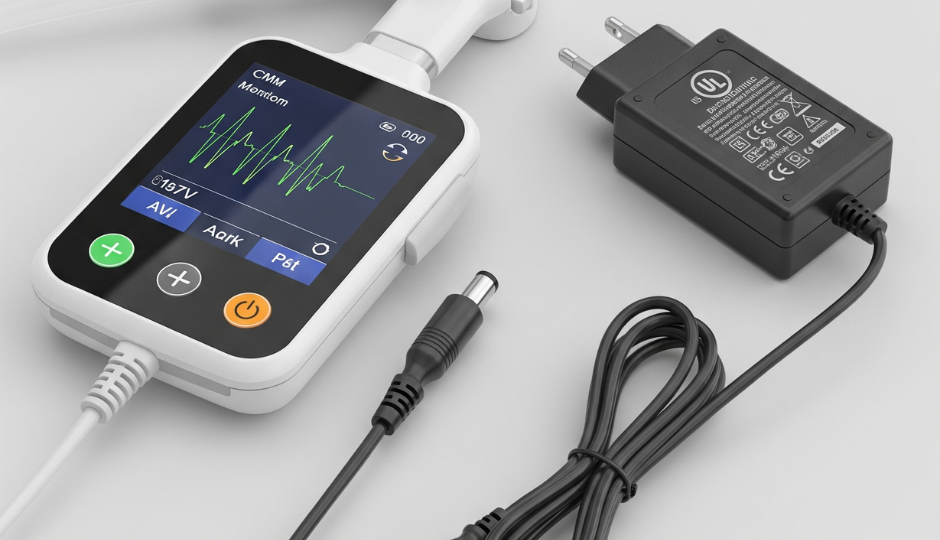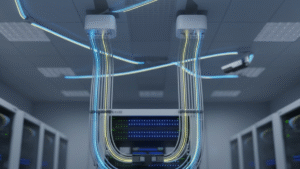Sleep apnea monitors are designed to track and improve your sleep health, but without a reliable power adapter, they can’t do their job. A faulty power source could put your entire sleep therapy at risk.
A power adapter ensures a stable and continuous energy supply to sleep apnea monitors, keeping critical components like sensors and processors running through the night. This supports accurate, uninterrupted data collection and analysis.

Many people spend time choosing a sleep apnea device, but forget to check the power adapter. Yet, this one small component can affect everything. Let me walk you through why it’s so important.
Why Is Power Stability Critical for Sleep Apnea Monitoring?
When your sleep data is being collected overnight, any interruption can lead to a loss of vital information. You can’t afford power fluctuations or shutdowns when a device is monitoring your breathing for health risks.
A reliable power adapter delivers a constant voltage, typically 12V or 24V, matching the device’s requirements. It protects the monitor from spikes or surges, which could otherwise damage the device or corrupt the data. Most modern sleep apnea monitors run on external AC-DC adapters that meet medical-grade safety standards like IEC 60601-1.

Let’s break down the key reasons power quality matters:
What Are the Key Power Needs of a Sleep Apnea Monitor?
If you’ve ever used a CPAP or home sleep testing device, you know how important continuous power is. These monitors are expected to function for 8+ hours straight, often with real-time Bluetooth or Wi-Fi connectivity and high-resolution data recording.
The main requirements include:
- Steady DC output – usually 12V or 24V
- Low ripple noise – to avoid interference with sensors
- Overvoltage and short-circuit protection – to keep the device and patient safe
- Compliance with safety regulations – especially medical certifications like UL, CE, and FDA
Here’s a quick reference table:
| Feature | Reason It Matters |
|---|---|
| Stable Output Voltage | Prevents data loss, ensures accurate monitoring |
| Medical Certification (IEC) | Ensures patient safety and hospital compliance |
| Low Ripple and Noise | Avoids sensor interference and false readings |
| Overcurrent/Overvoltage Protection | Prevents internal damage in case of surges |
| Long Lifespan | Supports overnight use every night, year-round |
These aren’t optional. They’re critical. I’ve worked with clients who overlooked power quality and had to recall entire batches of sleep monitors due to intermittent issues caused by cheap adapters.
Can Off-the-Shelf Adapters Work for Medical Sleep Devices?
At first glance, it may seem convenient to use general-purpose adapters. But when it comes to medical equipment like sleep apnea monitors, this can lead to serious problems. Off-brand adapters may lack proper insulation, overload protection, or medical certification. That’s not a risk worth taking in a product designed to monitor life-threatening conditions.
Certified medical adapters, like our UES36LCP series, meet stringent standards. They support continuous operation and pass strict EMC (electromagnetic compatibility) tests, meaning your sleep monitor won’t get or cause interference.

I always recommend selecting a power solution that was made specifically for medical use, not retrofitted after the fact.
What Should Product Designers Look for in a Sleep Monitor Power Supply?
I’ve worked with designers like David, someone who’s constantly under pressure to manage development timelines and control costs. For him, picking the right power adapter early in the design cycle avoids expensive fixes down the road.
Here’s what we usually review:
- Output voltage and current capacity
- Efficiency level (DOE VI or above)
- Size and thermal design (for integration into compact units)
- Global certifications (so the product can ship worldwide)
- Lead time and long-term availability
If you choose a trusted adapter supplier from the beginning, you avoid redesigns, compliance headaches, and support issues later. And yes, it helps your bottom line too.
| Key Factor | Why It’s Important |
|---|---|
| Output Specs Match | Prevents under-powering or device malfunction |
| Efficiency Standard | Meets energy regulations in export markets |
| Compact Design | Fits into sleek home-use devices |
| Global Certifications | Simplifies international sales and compliance |
| Supply Chain Reliability | Avoids production delays and shortages |
How Can a Good Power Adapter Improve User Experience?
We often focus on internal electronics or software UX, but power matters just as much to end users. Think about it—your sleep monitor is no good if it shuts off in the middle of the night.
A well-designed power adapter:
- Runs quietly (no coil whine or heat)
- Charges or powers fast and reliably
- Doesn’t heat up dangerously
- It is easy to plug and unplug
- It is backed by certifications that give users peace of mind
It also reduces customer complaints and warranty returns. I’ve seen companies cut support calls in half just by switching to a better adapter supplier.
That’s why I always tell designers—never treat the adapter as an afterthought. It’s part of the user experience.
What If the Power Fails During the Night?
This is where backup planning comes in. Many newer sleep apnea monitors come with small internal batteries for emergency use, but they can only last 30–60 minutes.
So the adapter is still your main power source. Some companies use adapters with built-in surge protection or recommend using uninterruptible power supplies (UPS) in areas with unstable electricity. For critical hospital use, power redundancy is a must.
Designers need to think about:
- Power outage risk in target regions
- Backup power planning
- Adapter durability under 24/7 use conditions
These are all parts of a good power supply strategy.
Conclusion
A reliable power adapter is essential to keep sleep apnea monitors running accurately and safely throughout the night.




